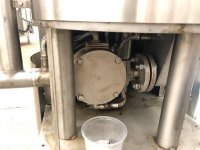Hello to all on the forum
This may not be the correct place to post this, so if anyone has advice on a better location, I would really appreciate the help.
My problem is with the ball mill that grinds chocolate from the roasted beans. There is a pump at the base that cycles the chocolate through and returns it to a spout at the top to reincorporate with the rest. The pump should be activated until the beans and sugar have ground up enough to flow. At this stage its basically a viscous suspension of melted fat and small solids like sugar.
The problem is that even with the pump off a small but continuous trickle of chocolate comes out of the spout. My first thought was that the shaft of the pump was still turning through some fault, either electrical or mechanical however I have verified several times that it is not turning even in the slightest. The fact that the chocolate is still passing through and going straight up a pipe WELL ABOVE th level of the chocolate in the mill is something that I cant get my head around. Im attaching photos to help, but if anyone knows what this is, I'll gladly send you out some chocolate.
Thanks!



This may not be the correct place to post this, so if anyone has advice on a better location, I would really appreciate the help.
My problem is with the ball mill that grinds chocolate from the roasted beans. There is a pump at the base that cycles the chocolate through and returns it to a spout at the top to reincorporate with the rest. The pump should be activated until the beans and sugar have ground up enough to flow. At this stage its basically a viscous suspension of melted fat and small solids like sugar.
The problem is that even with the pump off a small but continuous trickle of chocolate comes out of the spout. My first thought was that the shaft of the pump was still turning through some fault, either electrical or mechanical however I have verified several times that it is not turning even in the slightest. The fact that the chocolate is still passing through and going straight up a pipe WELL ABOVE th level of the chocolate in the mill is something that I cant get my head around. Im attaching photos to help, but if anyone knows what this is, I'll gladly send you out some chocolate.
Thanks!







